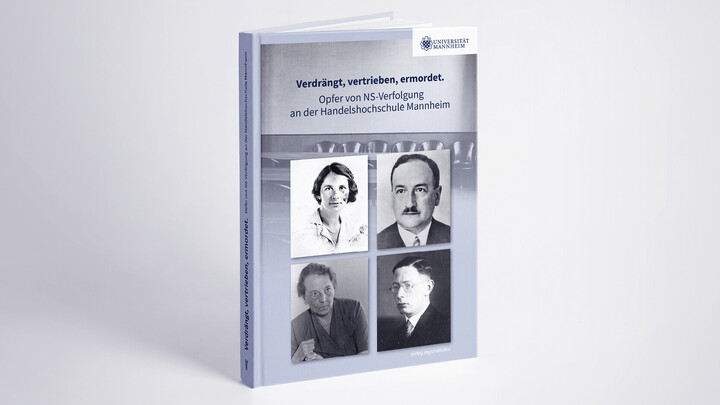Keeping Their Memory Alive
They were deemed politically undesirable, did not fit into the system, or were classified as Jewish by racial ideology: Numerous members of the Commercial College of Mannheim—the University’s predecessor institution—fell victim to persecution and exclusion under National Socialism. Last fall, an anthology was published documenting their biographies.

Even before the Nazis seized power in 1933, tensions were rising across the country. Economic hardship was widespread, political polarization was increasing, and the Nazi Party (NSDAP) made significant gains in the 1932 Reichstag elections. In 1933, after Adolf Hitler’s appointment as Chancellor, the Commercial College of Mannheim was incorporated into Heidelberg University. At least six of the 17 Jewish lecturers at the school did not survive the Nazi era. Many students, staff members, and honorary officials also became victims of the Nazi regime. Through two seminars led by Professor Dr. Angela Borgstedt and Dr. Sandra Eichfelder, students and participants in the University of Mannheim’s Guest Student Program, alongside external contributors, reconstructed 81 biographies in total.
Dr. Eichfelder, the head of the university archive, was confident from the outset that the research would be worthwhile. She had already contributed to a commemorative publication on the university’s efforts to come to terms with its past, released in 2021 for the 75th anniversary of its reestablishment as a college of business and economics. “It became clear that several issues still needed to be addressed. The current volume focuses on honoring the victims,” she explains. The President’s Office immediately supported this project, and in October 2024, Eichfelder and historian Borgstedt published the anthology Verdrängt, vertrieben, ermordet. Opfer von NS-Verfolgung an der Handelshochschule Mannheim (Displaced, Persecuted, Murdered: Victims of Nazi Persecution at the Commercial College of Mannheim).
A quest through the archives
“It all started as just a list of names,” recounts Barbara Woll, an older participant in the seminars. “But connections to individual names quickly emerged. One student on the list, Ludwig Kahn, came from Saarland – like me. I decided to focus on his story.” After an introduction to archival work, she and the other participants traveled to various archives, including in Saarland in her case. “It was like a real detective mission,” she describes.
The research required extensive effort, Eichfelder confirms. “The scattered nature of the records was one of the greatest challenges. Personnel files for the lecturers of the time are no longer in Mannheim but are mostly in Heidelberg, with some in Karlsruhe or Stuttgart. Similarly, most student records are housed at the Heidelberg University archives.”
Another challenge was starting with very limited information. “For some students, we had only a name from the matriculation book—sometimes without even a birth date,” Eichfelder notes. “With common names, finding further details was particularly difficult.” Woll adds, “In some cases, despite thorough research, the biographies remained very brief. But there were also instances where I initially thought I wouldn’t find anything—and then the pieces started coming together.”
One such case was Jakob Karl Kley, whose story Woll researched. “At some point, he no longer wanted to be part of the system because he disagreed with how things were going. The School of Commerce, where he worked part-time as a lecturer, dismissed him, but he continued serving as a district court director. He then took sick leave until his retirement application was approved.”
“A deeply rewarding collaboration”
Sabrina Brechtel, another seminar participant, researched three biographies. “The most fascinating case for me was Friedrich Röhrer. His story is ambiguous—it’s unclear whether he was a victim or a collaborator,” says Brechtel, who is studying history and German to become a teacher. Röhrer lost his position when the Commercial College was dissolved. On the one hand, he had been a Freemason in earlier years, and various sources suggest he held pacifist views. On the other hand, during the war, he served in a range of key offices and positions.
Brechtel explains, “His story particularly resonated with me because he, like me, was involved in education. His correspondence seemed very personable. But the records also show he was a member of Nazi organizations. It highlights the complexity of history—there’s rarely a clear black-and-white distinction, but rather many shades of gray. It’s essential to consider the pressures people were under.”
The research had a profound emotional impact, according to Brechtel. “The individuals whose biographies we explored lived in Mannheim and studied at the university—just like me. These personal stories make history much more tangible and gave me a new perspective on the topic.”
To Brechtel, there was another reason why the seminar was a unique experience: “The collaboration between younger students and older participants in the Guest Student Program was deeply rewarding. We complemented each other well. We younger students often approached the topic more analytically due to our greater distance from the events, while the older participants brought a deep personal connection and insight to the discussions. And not least of all, we were able to assist each other in practical ways: The older ones were better at deciphering old handwriting, such as Sütterlin script, while the younger students were more skilled in online research.”
Future seminar participants are likely to benefit from this collaboration, too. A follow-up seminar is planned for next year, Eichfelder explains. “In next year’s course, we will focus on the biographies of those who may have profited from the circumstances.”
Text: Katja Bauer / April 2025

The anthology Verdrängt, vertrieben, ermordet. Opfer von NS-Verfolgung an der Handelshochschule Mannheim is published by Verlag Regionalkultur (in German).
